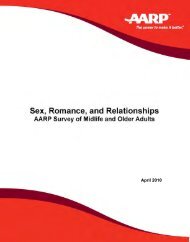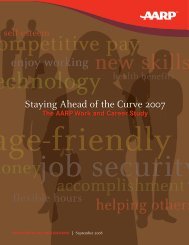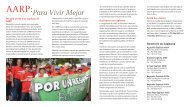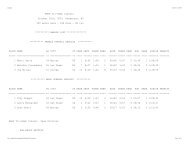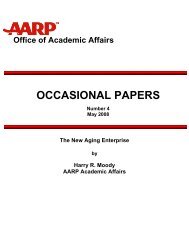Exercise Attitudes and Behaviors: A Survey of Adults Age 50-79 - Aarp
Exercise Attitudes and Behaviors: A Survey of Adults Age 50-79 - Aarp
Exercise Attitudes and Behaviors: A Survey of Adults Age 50-79 - Aarp
Create successful ePaper yourself
Turn your PDF publications into a flip-book with our unique Google optimized e-Paper software.
Sampling error<br />
Introduction <strong>and</strong> Method Overview<br />
All samples are subject to some degree <strong>of</strong> sampling “error”—that is,<br />
statistical results obtained from a sample can be expected to differ<br />
somewhat from results that would be obtained if every member <strong>of</strong> the<br />
target population were interviewed. In this report, the maximum margin <strong>of</strong><br />
error at a 95% confidence level is within +/- 3 percentage points for base<br />
sizes <strong>of</strong> 1,000. Subsample margins <strong>of</strong> error will be higher.<br />
Weighting<br />
Completed interviews were weighted by age, sex, education, <strong>and</strong> region to<br />
ensure reliable <strong>and</strong> accurate representation <strong>of</strong> the target population.<br />
Percentages not totaling 100%<br />
For tabulation purposes, percentage points are rounded <strong>of</strong>f to the nearest<br />
whole number. As a result, percentages in a given table column may total<br />
slightly higher or lower than 100%.<br />
In questions that permit multiple responses, columns may total<br />
significantly more than 100%, depending on the number <strong>of</strong> different<br />
responses <strong>of</strong>fered by each respondent. Similarly, when only selected<br />
responses are shown, percentages may total less than 100%.<br />
Asterisks (*) are used when percentages fall below 0.5%. A dash (-)<br />
indicates 0%.<br />
Multivariate segmentation<br />
In order to determine whether or not Americans <strong>50</strong>-<strong>79</strong> group themselves<br />
according to shared attitudes about exercise <strong>and</strong> fitness, RoperASW<br />
statisticians conducted a multivariate segmentation (K-Means) <strong>of</strong><br />
respondents into six groups based on their level <strong>of</strong> physical activity <strong>and</strong><br />
attitudes toward exercise <strong>and</strong> fitness (Qs. 7, 5a, 13, 14 from the first<br />
wave). Results are discussed in Chapter VII.<br />
© 2002 AARP Page 6



